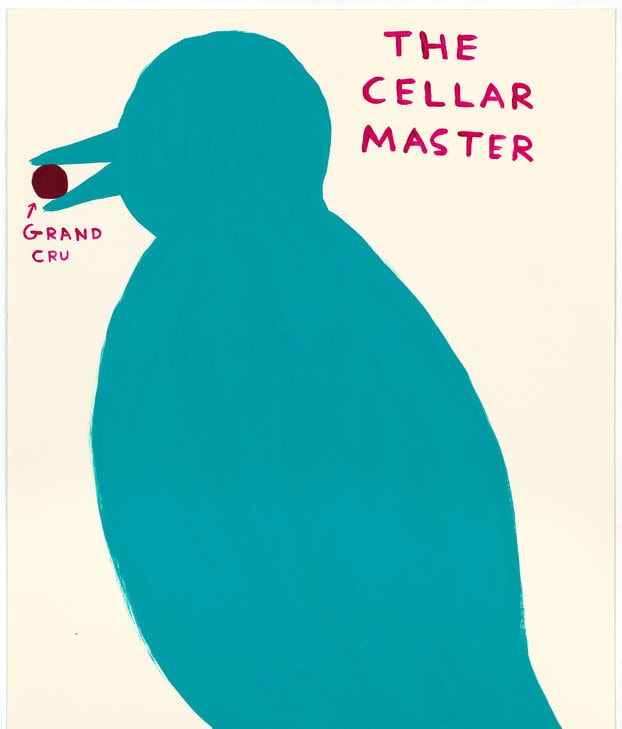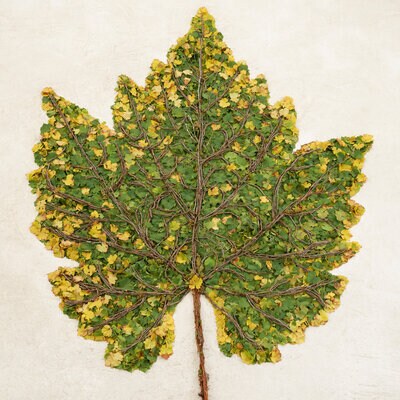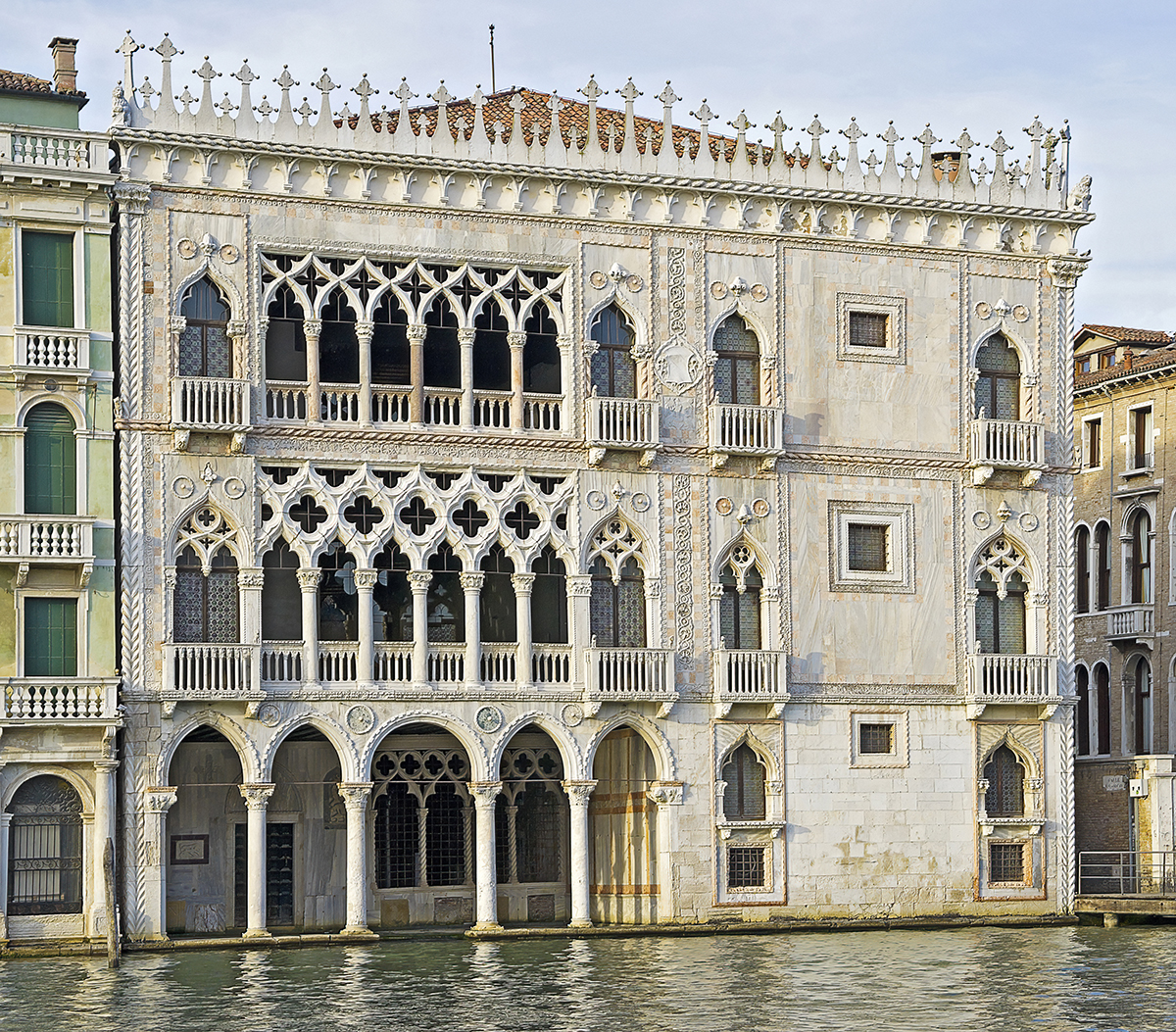
Jeppe Hein before a speech-bubble message and chalk panel, elements of the artist’s multimedia, interactive project for Ruinart Carte Blanche 2022, ‘Right Here, Right Now’
When Danish artist Jeppe Hein was given the coveted Carte Blanche commission by champagne house Ruinart, he was determined to create something quite different, by taking art-fair visitors back to nature and making an appeal to the senses. Candice Tucker reports
We are lying on the ground surrounded by by trees, breathing slowly, ever more slowly. The silence and peace is palpable. Stress ebbs away, nature flows through us. There is a gentle waft of incense and the sounds of the countryside.
It is a comforting, uplifting experience, probably about as far from the hubbub and glamour of an art fair as conceivable. And that is just what the Danish artist Jeppe Hein had in mind, when he took us on an excursion as part of his Ruinart Carte Blanche commission.

The artist experiencing the Ruinart estate through the senses, part of the responsive idea of his Carte Blanche work
Carte Blanche is Ruinart’s annual series, begun in 2017, in which leading global artists are given, well, carte blanche, to create what they like (well, almost – there are some limits, we imagine), as a tribute to the historic champagne house. The artists’ resulting work, in this case Hein’s ‘Right Here, Right Now’, and a rolling associated art programme (of which we were part in this moment) then travel the globe to be showcased at the world’s greatest art fairs, including Frieze in London and New York, Art Week Tokyo and Art Basel Miami.

A chalk face drawn on another panel
At this point, as part of his project, Hein was taking us, an assembled group of the world’s art media, back to nature. We were at the Royal Pavilion at the Bois de Boulogne in Paris, a peaceful setting in a huge park on the edge of one of the world’s great metropolises.
Follow LUX on Instagram: luxthemagazine
In that moment, he succeeded, and again, as the nature vibe continued over a meditative lunch in the Pavilion (vegetarian because, of course, the artist wanted us to commune with the world of plants and trees). By extension, the concept of sustainability continued with it.

The artist at the exhibition
Nature, and a return to it, is a common theme in both Hein’s life and his often playful experiential art. He was raised on a biodynamic farm in Denmark, and his art has long explored the space between the natural world and what we make of it and from it. He famously declared burnout in 2009 and said he was going to slow down and reconnect with nature. He now lives by the Grunewald forest, a kind of equivalent to the Bois de Boulogne on the edge of Berlin.

visitors contribute to the artwork with chalk drawings
Champagne, meanwhile, is a product of nature, but one that also needs the careful craftsmanship of humans. Unlike wine, it could not occur naturally, as it needs a painstaking second fermentation process in the bottle to become what it is. Ruinart is a champagne beloved of the world’s art collectors. On any collector’s yacht, you are likely to be served its Blanc de Blancs, an ethereal, delicate yet richly seamed creation made of Chardonnay grapes. At a soirée, you will likely be drinking Ruinart Rosé, with its undercurrent of summer berries and autumn woodlands from the combination of Chardonnay and Pinot Noir grapes.

Jeppe Hein makes his own mark on a chalk panel
Hein’s ‘Right Here, Right Now’ considers peace, the senses and interactivity in response to the world of Ruinart. At the Palais de Tokyo in Paris, 10 minutes from our lunch, installations included a column with a hole. Put your hand in and a raisin comes out: you must eat the raisin following specific instructions to ensure you appreciate each of your senses. In another column hole, there is a spray of perfume. There are also installations on a wall on which you can draw faces in chalk, so your own marks become part of the artwork – chalk makes up the underlying soil of much of the Champagne region, and is intimately associated with Ruinart. Further artworks feature speech bubbles that carry messages of mindfulness. There is an appeal to all five senses and all four elements.

a speech-bubble message invites consideration of sensorial responses
The gastronomic side is equally important for Hein. And, we imagine, for Ruinart, as there can be few better accompaniments to very pure cuisine of the highest level than the highest quality champagne, with its clean direction and precision. Five leading chefs are creating a “gastronomic dialogue” with Hein as part of this “nomadic artistic adventure”, travelling during 2022 from Paris to London to Miami, and points in-between. “We invite people to experience Ruinart champagne, the chefs’ food and my art, at a totally new level,” says Hein.

The artist considers the scents of plant life on the Ruinart estate. Opposite page: work from previous Ruinart Carte Blanche projects
What does the artist himself think about what he is creating? “I was very inspired to go to Champagne and see so much creativity, precision and inspiration. There was a link to my own studio, to how I get an idea, or work around an idea and try to make models and express it and, in the end, it comes out. I fell in love with the champagne cellars – they have 11km of them. We walked along them, there was a yellow light and it was eight degrees or something. If you touch the walls they are wet. All these physical experiences got me totally engaged into trying to bring that feel to the art fair, to the experience of people there.”
Read more: An Interview With KAWS
‘Right Here, Right Now’ is, he says, “about the moment of being here. When you take the chalk in the interactive installations and start to draw, you are in the moment, not thinking too much. I’m trying a few things with the sense of smell, which goes straight to the brain and can reflect on something you smelt when you were five. Smell is always activating old memories, which I think is beautiful. When you’re working with all the senses, you can activate a lot of feelings. In my work, I’m not trying to be in your head, I’m trying to bring you into your body.”
It is a quite different experience to the usual art-fair hubbub; one perfectly enjoyed over a creamy, delicate glass of Ruinart Blanc de Blancs.
Past Masters
Since 2017, leading contemporary artists have responded to Ruinart via the champagne house’s annual Carte Blanche initiative. Here is a glimpse of some of the works

Lui Bolin, 2018
In ‘Reveal the Invisible’, the Chinese artist created eight almost hidden works that considered the quiet tasks undertaken by workers to create Ruinart champagne.

David Shrigley, 2020-21
Across 42 artworks, in ‘Unconventional Bubbles’ the British artist provoked witty debate about nature and raised awareness of the environmental challenges that motivate Ruinart

Vik Muniz, 2019
In ‘Shared Roots’, the Brazilian artist made a series of pieces using Chardonnay vines and other raw materials that form part of Ruinart’s transformative work
Find out more: ruinart.com/carte-blanche
This article first appeared in the Autumn/Winter 2022/23 issue of LUX












Recent Comments